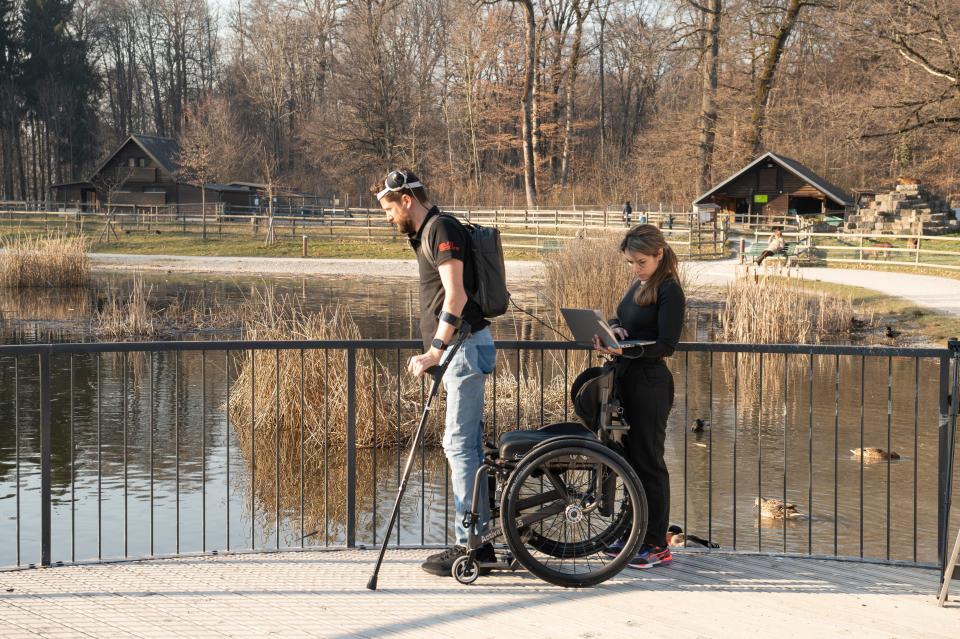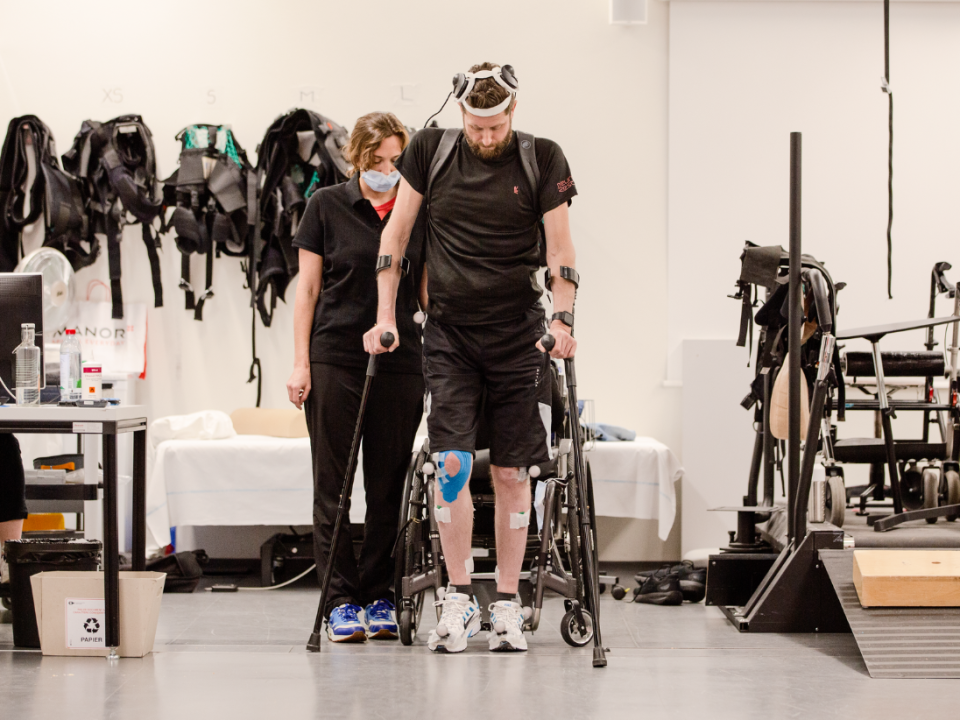From 'science fiction' to reality: Paralyzed man walks again thanks to brain and spine implants
A Dutch man whose spinal cord was injured in a bike accident a dozen years ago can now walk thanks to stimulators implanted on his brain and spinal cord, according to a study published Wednesday.
Previous versions of the spinal cord stimulation that Gert-Jan Oskam received have helped people stand and take steps, but only after first pushing a button to activate the device. The new system enables him to merely think about walking before he can do it.
Stimulation from both points reestablishes communication between the brain and the area of the spinal cord that controls leg movements, enabling more natural walking, said Grégoire Courtine, who helped lead the research.
“It was quite science fiction at the very beginning but it became true today,” said Dr. Jocelyne Bloch, co-leader and a neurosurgeon at the University of Lausanne in Switzerland.
After practicing for a while and perhaps because his spinal cord wasn’t completely severed, Oskam, 40, can now take a few steps on crutches, even with the stimulators turned off. With them on, “depending on the day,” he can walk 100 to 200 meters – the length of one or two football fields.
“For 12 years, I have been trying to get back on my feet,” he said on a Tuesday call with media.
Being able to walk at will provides independence, particularly at home. Oskam was in his new house last week when he saw something that needed to be painted.
“There was nobody to help me, so I took the walker and did it myself as I was standing,” he said.
With a stimulator just in his spinal cord, the stimulation was controlling him. Now, with devices implanted in both spinal cord and brain, “I’m controlling the stimulation with my thoughts,” he said.
Although Oskam is the only person whose results with the stimulators are published, researchers hope they will eventually help many more spinal cord injury and stroke patients get up out of wheelchairs. Standing also helps improve functions like bladder control, blood pressure and sweating.

Researchers discovered in the 1980s that stimulators could improve mobility in people with certain diseases and injuries. For the last dozen years or so, a number of teams, including Courtine’s, have been working to better understand the signals between brain and muscles so they could more precisely place stimulators to maximize their effect.
The new research, published in the journal Nature, is the first to stimulate both spinal cord and brain, enabling signaling that was disrupted by his injury. Once they were reconnected, the weak signals Oskam’s body still sent were reinforced, allowing him mobility even when the stimulators are turned off, researchers said.
Theoretically, the process will also work for people with more severe spinal cord injuries than Oskam’s and will work even better for people whose injuries were recent – though both have yet to be proven.
The pulses come at the right time to enable Oskam to move each leg in turn, providing a natural-looking gait, not robotic, as previous stimulated walking has been, said Courtine, a neuroscientist and professor at the École Polytechnique Fédérale de Lausanne.
“The technology is still in its infancy, although it is tremendous technology,” he said.
Related: 'New frontier' in therapy helps 2 stroke patients move again – and gives hope for many more
With a single stimulator, Oskam could make steps but only if he was in sync with the rhythm provided by the stimulator, which he found stressful. “This whole stress is gone now,” he said. He needed to relearn how to walk naturally after teaching himself to walk with the single stimulator. Although he felt like a toddler, he learned quickly, said Courtine and Bloch, taking natural steps the first day of rehabilitation after the second implant.
Before, the stimulation was either on or off, but now, “the more he thinks about the movement, the more the amplification of the stimulation increases,” said team member Guillaume Charvet, a researcher with France's atomic energy commission.
Next, the group plans to miniaturize the hardware needed to run the system, which Oskam now carries in a backpack. That’s appropriate for laboratory research, Courtine said, but needs to be much smaller to make it usable in the real world.
The team also hopes to launch a clinical trial in about a year, likely in the United States. Stimulators have not yet been approved for use in spinal cord injury patients.
Courtine has launched a company, called Onward, to lead commercial advances of the technology.
More: Study finds brain 'signature' for chronic pain, which could improve diagnosis, treatment
'That’s something nobody’s achieved before'
Other researchers in the field were enthusiastic this week about the advances the team showed.
Peter Grahn, an engineer in Mayo Clinic's Department of Neurologic Surgery, said he found “impressive” the ability to stimulate both the spinal cord and brain, essentially in real time. “That’s something nobody’s achieved before,” he said. The same group showed similar results in monkeys before, but “this is way above and beyond that.”
The field has been conceptually moving toward this brain-spinal cord connection for years, Grahn said. “Now that it’s been realized, it will only make this field move faster and with more confidence.”
Marco Capogrosso, an assistant professor at the University of Pittsburgh, helped lead the monkey research when he was in Courtine’s lab. He “finds it very cool” that the same system is so effective in a person.
Enabling someone to get out of a wheelchair and take a walk relieves the risk for pressure sores and improves circulation among other biological functions, Capogrosso said.

More: Paralyzed patients walking in minutes: New electrode device a step forward in spinal injury care
Legs move at a regular pace and within a limited range, so walking is easier to recreate than arm movements.
The group behind the new research is “indeed investigating how we can use the same principle to restore arm movements,” said team member Henri Lorach. They are currently recruiting three participants for a clinical trial to restore arm movements using stimulators, Courtine said
Reconnecting the brain and lower spinal cord is essential for a natural gait because it enables the body to know where the legs are in space, said Reggie Edgerton, a UCLA researcher who has led the field for decades and was a mentor to Courtine.
Without that knowledge, the body is like a cellphone trying to provide directions without knowing your location.
“If your brain doesn’t know where your body parts are, how can it generate a complicated pattern to tell you to get" where you want to go, he said.
Oskam said he now has close to normal sensation in his left leg and can feel that he’s applying pressure to the ground with his right when he walks, “which allows me to make a good step.” He said he’s more interested in the quality of his steps than in distance.
“For me, the most comfortable is 20 to 30 meters," he said, which is about the length of a bowling alley. "Not walking a marathon.”
Stimulators will never perfectly replicate natural movement, Edgerton said.
“It’s hard to imagine how any technology is going to match what 300 million years of evolution has figured out,” he said. “But that doesn’t mean we can’t make considerable improvement.”
Capogrosso said the new work reminds him of the dream actor Christopher Reeve had after he was paralyzed in a 1995 horseback riding accident. Reeve, who played Superman in four movies before becoming a disability advocate, described himself showing off the "breakthrough of the year," by standing up out of his wheelchair and walking across a stage.
“That’s what we did here,” Capogrosso said. “This person can stand up and walk on the stage – and this is huge.”
Contact Karen Weintraub at kweintraub@usatoday.com.
Health and patient safety coverage at USA TODAY is made possible in part by a grant from the Masimo Foundation for Ethics, Innovation and Competition in Healthcare. The Masimo Foundation does not provide editorial input.
Latest A new research effort takes aim at 8 rare diseases. It could revolutionize many more.
This article originally appeared on USA TODAY: Paralyzed man walks naturally with brain, spinal cord implants

